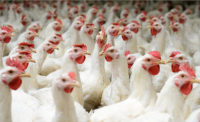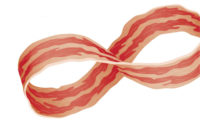Overall sales of poultry were down less than 1 percent in 2016 from 2015 because of a decline in poultry prices as well as total volume of poultry sold, according to Chicago-based Mintel International’s Poultry U.S. report, published in November 2016. While sales are forecast to reach nearly $27 billion by 2021, this is less than 2 percent growth year over year.
Mintel’s foodservice analyst Caleb Bryant believes poultry’s price drop can be attributed to the price of beef dropping dramatically, with forecasts projecting this trend will continue.
“More people are making the switch because they are noticing these prices,” he says. “Now, this might dampen a bit in the future even though beef will continue to lower in price, but because beef has been so expensive in recent years, people are really feeling it in their wallets right now.”
In the meat case, Nielsen Perishables Group, Chicago, reports chicken resembles trends seen across the case, where supply is at record levels, which drives prices down, and therefore dollar volume is also down. For chicken, prices fell 1.8 percent for the 52 weeks ending Oct. 1, 2016. This actually didn’t incentivize more volume, which was flat vs. a year ago, meaning dollar volume also dipped 1.8 percent. Turkey followed suit, Nielsen Perishables reports.
“While this data shows that prices are up, that will change once Thanksgiving 2016 replaces last year’s holiday in the report,” says Mike Olson, director of Nielsen Fresh.
Taking in the dynamics of the total meat case, Olson agrees that beef prices being down nearly 10 percent year over year has consumers flocking to that protein.
“The price declines in beef may be pulling meat shoppers away from other meats, which may explain how chicken is flat on volume despite being 1.8 percent more affordable,” Olson says.
Nielsen Perishables sees cuts that own the greatest category share also growing in dollars. For example, boneless skinless chicken breast is up 0.7 percent in dollar sales and tenders are up 2.2 percent. Smaller share cuts driving growth include boneless thighs (up 11.8 percent) and ground chicken (up 10.8 percent). The explanation here may be the trend of convenience-seeking exhibited by consumers aligned to the rise of meal kits and value-added meat, Olson says.
Nielsen Perishables sees some drags on the chicken category dollar sales with whole chickens (down 10.3 percent), chicken legs (down 9.2 percent) and chicken thighs (down 4.1 percent). In turkey, ground turkey makes up 46 percent of annual sales and is down slightly in dollars (down 0.3 percent), and most other cuts are slightly down except for marinated/seasoned turkey, which is up 1.3 percent, Nielsen Perishables reports.
In restaurants during the past year, chicken, duck and turkey were flat in menu penetration changes (percentage of restaurants offering), according to Datassential, Chicago. Chicken is a menu essential found at 96 percent of restaurants and showing little change in menu penetration during the past 11 years, the research firm says. Turkey is found on 45 percent of menus, down 7 percent from 2012 to 2016. On the other hand, duck is found on 19 percent of menus in 2016, up 9 percent from 2012.
“We can see how these items did on menus this year versus prior years, with the idea being that the more they are being featured on menus, the better they are selling,” explains Claire Conaghan, Datassential’s senior account manager. “If they are being removed from menus, the opposite is true.”
Natural and convenient trendy
Overall consumers have a very positive opinion of poultry, found Mintel, who surveyed consumers asking them what associations they have with poultry compared with other proteins.
“They call it healthy,” Mintel’s Bryant says. “They call it versatile, inexpensive, tasty and easy to cook.”
In addition, consumers find poultry claims appealing, but more importantly, they are willing to actually spend more on certain claims. Retailers can charge a price premium for claims such as organic and humanely raised, Mintel reports.
“Overall, we are seeing this movement in retail food and all of foodservice that consumers are looking for free-from and feel-good products,” Bryant says.
For example, consumers are looking for products with short ingredient lists that are natural or organic and lacking hormones. In addition, products with claims that make people feel good about purchasing them — such as sustainable, humanely raised or vegetarian fed — also are trending upward. Although sales of poultry may be down, many of the standout brands doing well feature products with such claims, such as Perdue Harvestland, Just Bare, Golden Platter and Foster Farms, Bryant says.
“Conversely, a lot of products that aren’t doing well, they tend to not have any of these claims,” Bryant says. The health and wellness market is a steady growth engine for poultry in the meat case too, with remaining room for growth, says Olson.
“The data shows tremendous growth numbers associated with natural and organic poultry,” he says. From a share perspective, natural and organic products are a small part of the category. Eight percent of chicken is natural, while 13 percent of turkey is natural, 3 percent of chicken is organic and 1 percent of turkey is organic. From an absolute perspective, though, these claims are driving significant business, Olson says. For example, natural accounted for a total of $1 billion and organic $311 million.
“Paired with the growth numbers, this validates the growing taste among consumers for cleaner, better and more responsibly raised meat,” he says.
Moving forward, Olson feels that poultry companies need to continue to build a differentiated assortment in the meat case that appeals to the myriad shoppers with differing demands.
“Chicken has led the way among meat types in bringing products that deliver on health and wellness demand,” he says. “Poultry — chicken and turkey — has also developed demand for brand names more than other proteins, especially beef.”
Not surprisingly, one of the top-growing poultry terms on menus is natural chicken, up 65 percent from 2012 to 2016, Datassential reports.
“Focusing on sourcing and the heritage of proteins is a trend that continues to grow,” Datassential’s Conaghan says. “Beyond that we also see pulled chicken increasing 58 percent during the past four years. This follows years of seeing pulled pork increasing, and now operators are seeking out a healthier alternative by offering pulled chicken for health-conscious guests.”
Room to grow
Declining pork pricing has resulted in significant innovation for pork on menus, and poultry still lags behind in this area.
“Helping restaurants understand the versatility of poultry will be important in 2017 and beyond,” Datassential’s Conaghan says. In prior years, turkey often did well in restaurants as a healthier alternative to pork, e.g., turkey bacon and turkey sausage. That has been decreasing more recently, Conaghan says.
“Now consumers are looking to have a smaller amount of very flavorful proteins, even if they are more fatty, and this often affects poultry offerings negatively — though it has helped duck experience a bit of a resurgence,” she says.
Looking at the top-growing proteins in restaurants during the past eight years, eight of the top 10 are pork-related, which is a concern for poultry, Conaghan says. “These top-growing items are more fatty and often more flavorful,” she says.
Examples of top-growing proteins related to pork include candied bacon, up on menus 286 percent from 2012 to 2016; pork belly, up 156 percent; and pork meatballs, up 105 percent.
“Considering ways that poultry can work in similar applications might be helpful,” Conaghan says.
On the other hand, poultry fits with the trend Public Health 3.0, which includes functional foods, especially protein along with grain and protein bowls. Another protein trend that may have an impact on poultry in restaurants in 2017 is increased interest in alternative non-meat proteins such as pulses and soy-based offerings, Conaghan says.
Beyond descriptors for chicken, such as natural, other areas of growth for poultry include Nashville hot chicken and chicken & waffles offerings, both of which continue to increase at independent and chain restaurants, Datassential reports.
In addition, Datassential continues to see more dark-meat callouts — an increase of 30 percent during the past four years. Chicken thighs also are up 29 percent during the past four years.
“We expect this to continue as Americans who love poultry become more open-minded,” Conaghan says. “Guests have finally been looking beyond pork chops and steak in relation to pork and beef, and now they are beginning to look beyond boneless, skinless chicken breasts in relation to poultry.”
Additionally, ethnic flavors continue to grow, which can be leveraged with poultry because it often has a more neutral flavor, Conaghan says.
“The blank canvas of poultry allows for a wider application of flavors,” she adds. Consumers are also open to innovations in the retail poultry market too. While consumers are interested in trying a variety of new poultry products, Mintel found that products that cut down on some of the stresses of cooking may be the greatest area of opportunity. For example, individually wrapped breasts reduce the chance of freezer burn and allow consumers to cook exactly the amount of poultry they need. Similarly, easy-thaw and ready-to-cook pre-seasoned poultry products provide consumers with fast and easy meals.
“Consumers are looking for those products that are clean label, but do save them time,” Bryant says.
Mintel’s consumer data also showed that younger consumers seem to be a bit uneducated about cooking poultry and storing poultry. For example, 35 percent of iGen (or Generation Z) consumers say they worry about undercooking poultry compared with only 24 percent of Baby Boomers. In addition, 21 percent of Millennials said they sometimes throw poultry away due to freezer burn compared with 8 percent of Baby Boomers.
“The youngest generations, as they are entering college or entering the workforce, this might be the first time they are cooking for themselves and they are worried they don’t have the experience to actually cook poultry,” Bryant says.
Nielsen Perishables also sees consumers demanding convenience, which means offering pre-seasoned/marinated, pre-portioned and smaller pack sizes in the meat case.
“Assessing the availability and quality of these benefits alongside retail price is how shoppers solve their value equation and decide how to purchase categories,” Nielsen Perishables’ Olson says. “Manufacturers and retailers must simply deliver the value that consumers demand.”
Given rising supply of meat, it stands to reason that the meat case will continue to see prices depressed, keeping sales down.
“It’s important for manufacturers and retailers to keep close watch over consumer trends and demand,” Olson says. “By consistently putting the consumer at the center of meat-case strategy, consumption should remain strong and get us through the current supply glut.” NP
Eating more chicken
Chances are eight out of 10 shoppers in the checkout line right now have some type of chicken product in their carts. A 2016 survey by the National Chicken Council (NCC), Washington, D.C., found that 87 percent of consumers ate a chicken meal or snack purchased from a supermarket and 72 percent ate a chicken meal or snack from a foodservice establishment in the two weeks leading up to the survey.
“People are buying more chicken than last year and plan to buy more next year,” says Tom Super, senior vice president of communications for the NCC. “Chicken tops the list of protein being consumed most often per week. And while retail sales continue to be strong, the survey shows that more people are eating chicken away from home, which is good news for chicken producers, foodservice establishments and the overall economy.”
Consumers’ taste for chicken shows no signs of waning, either. In the 12 months following the survey, 21 percent of consumers anticipate eating more chicken from the supermarket and 14 percent anticipate eating more from a foodservice establishment. While supermarket numbers increased 2.4 percent and are now at parity with those seen in 2015, foodservice establishment consumption shows a noteworthy 7.5 percent increase from 2015.
NCC’s survey found consumers with the highest consumption levels tend to skew younger, more affluent and ethnically diverse with larger households. Among gender, total chicken consumption was split evenly.
“For many, chicken is the go-to food for lean meat, because of its low-fat and high-protein content, its versatility, variety, affordability and nutrient richness,” Super says. In fact, according to U.S. Department of Agriculture estimates, Americans ate 92 pounds of chicken per person in 2016, a record amount, he says.
Supplies of beef, pork and chicken are on the rise, and at the same time U.S. per capita meat consumption is expected to return to an all-time peak by 2018, Super reports. Most meat and poultry analysts agree that robust export sales will be the most critical component for the success of the industry in the next few years ahead, but the strength of the U.S. dollar, competitive pricing in world markets and the pace of economic growth in trade destinations will all be important factors in that success, he says. In the short term, abundant grain and oilseed crops should make navigating these waters more manageable.
On the broiler side, China will be the biggest variable that could determine the degree of success the chicken industry has in increasing export sales. China banned all U.S. poultry, including breeding stock, in January 2015, based on detection of highly pathogenic avian influenza in wild birds in Oregon. Chinese domestic production is predicted to decrease by 5.5 percent in 2016 and 10.4 percent in 2017, according to U.S. Department of Agriculture Foreign Agricultural Service, signs that the shortage of breeding stock is taking a toll.
“China remains our only trading partner with a ban still in place, and the U.S. government and poultry trade associations continue to work to negotiate the re-opening of this market,” Super says.
Turkey focuses on increasing demand
For turkey, production and supply rebuilt during 2016.
“The 3 percent loss in the turkey population did not affect supplies during the previous year’s 2015 losses from highly pathogenic avian influenza,” says Keith Williams, vice president of marketing and communications for the National Turkey Federation (NTF), in Washington, D.C. “The concentration of losses in the region surrounding the largest turkey-producing state affected producers there, while production in other states moved to fill in the supply.”
Turkey breast meat prices soared to record highs, more than $5 per pound in the latter part of 2015, and remained above $3 per pound into 2016. Ultimately, though, production has returned to normal levels, and U.S. Department of Agriculture expects production to finish at least 3 percent higher in 2016 than the 2015 deflated levels from bird flu — and even above 2014, a year of more normal production. The return to more typical market conditions has driven down prices, with breast meat trading closer to $2 per pound as of November 2016.
Based on the enthusiasm of NTF’s members and what the industry sees anecdotally (turkey burgers appearing more often in gourmet burger chains and the desire for turkey sausage and turkey bacon in breakfast offerings), interest in turkey continues to invite innovation on the part of turkey producers, ideation by chefs looking for new presentations and fresh suggestions from registered dietitians.
NTF’s members also are directly involved with its project to increase demand for turkey. NTF follows an overall approach to keep turkey top of mind for chefs building on turkey’s flavor and inviting new dishes as they influence menu selections. The project also engages registered dietitians who recommend the lean protein varieties found in turkey, such as ground turkey for turkey burgers, turkey meatballs and discovering easy recipes for turkey tenderloin.
“Our members have embraced our turkey demand project as an ongoing promotion, financially supported and positively reinforced by the work of our member companies, and are expecting, as we are, an increase in the profitable demand for turkey to continue beyond 2017,” Williams says.















